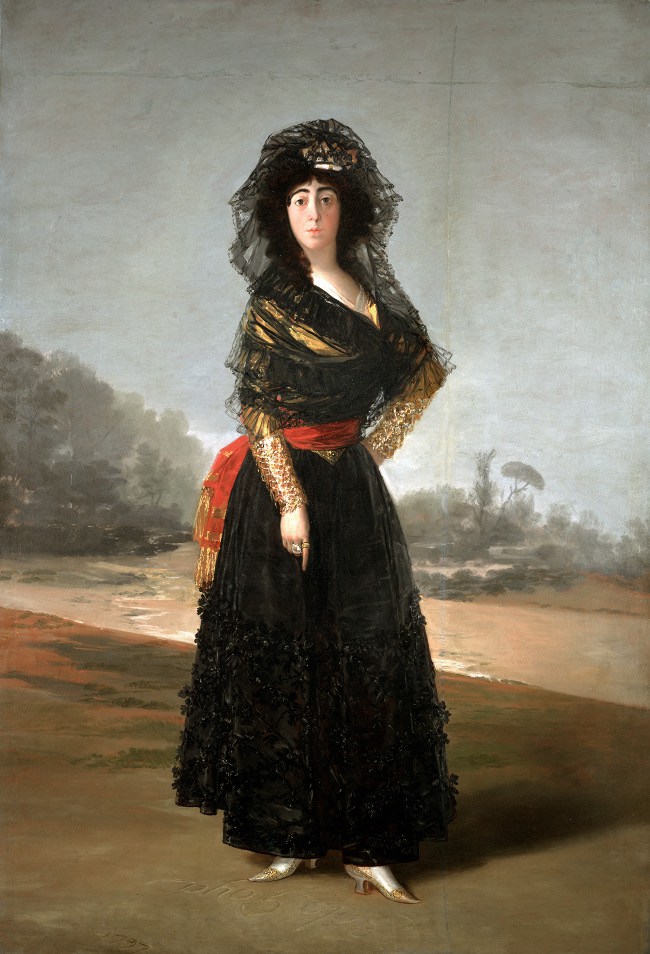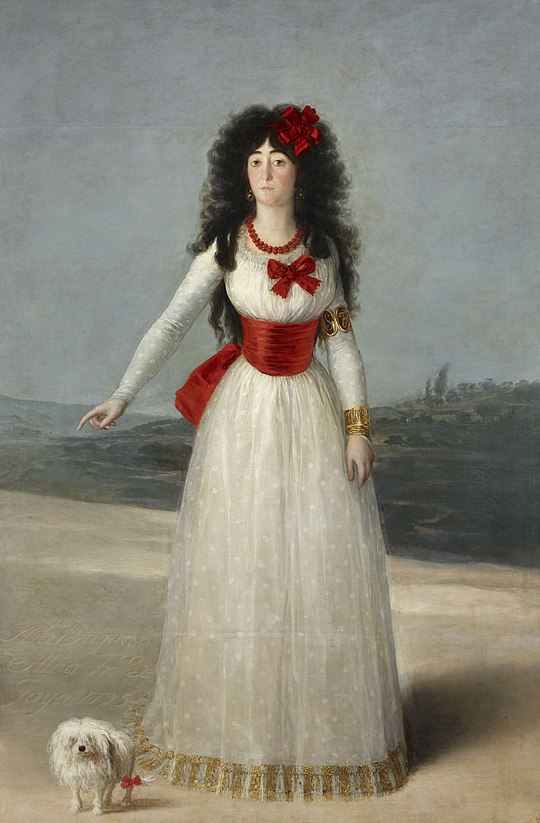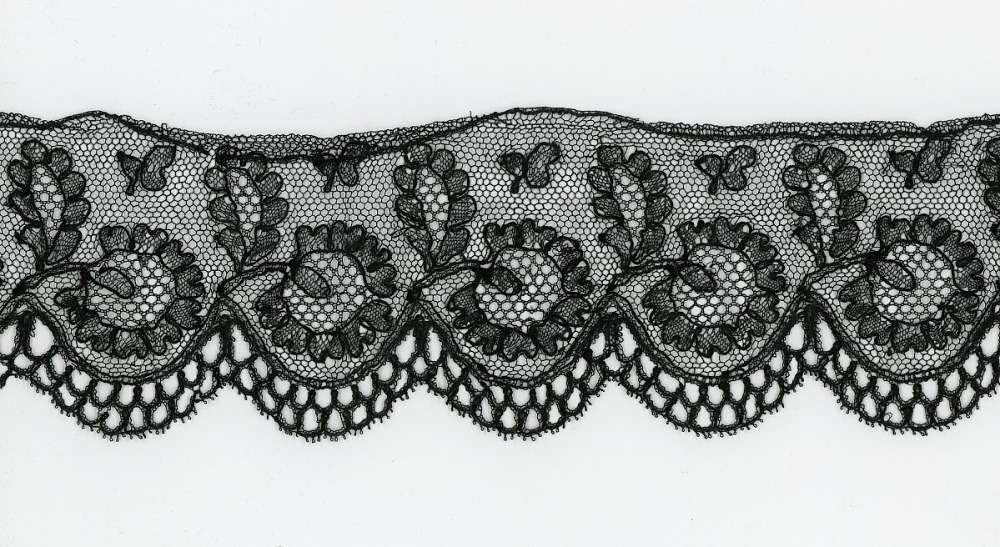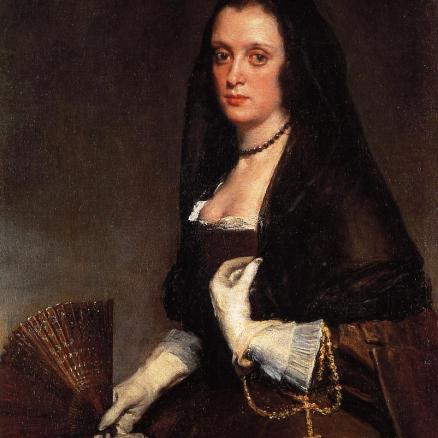Available for Purchase.
"*" indicates required fields
This submission is an inquiry of availability and details but does not guarantee a sale. Thank you for your understanding.

Francisco Goya, The Duchess of Alba 1797, oil on canvas

No people are more associated with the fashion of black lace than the Spanish. No lace is more linked with black than French Chantilly. And no painting more delightfully illustrates these intertwined traditions than Goya’s 1797 portrait of the Duchess of Alba.
Goya painted many portraits of Dona María del Pilar de Silva, the 13th Duchess of Alba, possibly even as La maya desnuda. Were they lovers? That’s a question that’s set tongues wagging since the liaison in Andalusia that produced the so-named “The Black Duchess” above.

Certainly, they were an unlikely pair. Goya’s humble origins would have placed him well out of social range of the Duchess (second in line behind the Queen) were it not for the fact that he had been appointed court painter for Charles IV in 1789. Goya was charming; the Duchess was flamboyant and provocative. She had endured a loveless, childless marriage. Her husband, the 13th Duke of Alba, had died the year before and, according to custom, the Duchess retreated to her summer residence for a period of mourning. Goya followed, making numerous sketches, etchings and paintings of her over the many months. From the many sketches of that period which are not of Dona María, but resemble her, it is clear that she was never far from his thoughts.
Goya places her in a landscape unencumbered by distractions, she alone holds the viewer’s gaze. He depicts her in mourning costume; though a style more likely worn by the maja, or peasant classes in Spain, than by the aristocracy, it is by no means simple or austere. A black lace mantilla, which alluringly snakes itself around her, performing double duty as a headdress and fashionable shawl over her traditional Andalusian ruffled mourning dress.

On the Dowager’s fingers are two rings, one stating “Alba,” the other proclaiming “Goya.” The Duchesse also points words—sólo Goya (“Goya alone”)— on the ground in front of her. The first word was hidden for many years by paint and varnish, but when it was revealed after a cleaning in 1960, speculation heated up once again. The record shows that Goya and Dona María parted unhappily after their sojurn in Andalusia. It remains a mystery as to whether sólo Goya represented her true feelings at the time or just his secret wish.
The Duchess died at 40 under sinister circumstances. The mantilla passed largely into history, though black lace is still worn by many women of an older generation as a religious head covering in some countries and by all non-Catholic female dignitaries meeting the Pope. Chantilly lace, of course, was immortalized in the Big Bopper song.
Undoubtedly the best-known of the black laces, Chantilly is a bobbin lace worked in silk threads, rather than the more common flax or cotton. Named for the French town of its origin, Chantilly is distinguished by its fine Alençon-type réseau (netting) and outlined motifs—mostly floral patterns. The strong but comparatively light weight of this lace once made it suitable for an especially wide range of fashion accessories—the delicate covers of parasols and fan pages, as well as large shawls, although sizes of the latter was severely limited until 1758, when a French lacemaker from Calvados discovered the invisible seaming technique called point de racroc.

Black lace first arose as a fashion need in the 16th century (predominantly as a symbol of mourning or matronliness). By the 17th century, equal quantities of black and white Flemish lace show up in purchase records. Regrettably, portraits of the era serve as the only record of the uses of black lace; almost none of the early specimens survive, because the iron-oxide mordant used to fix the black dye caused the threads to rot. (Synthetic dyes would fix this problem in the 19th century.)

The earliest Chantilly laces were made from cream-colored, not black, silk threads. Blonde, as it was called, was a fragile lace, since the thin passive threads were required to support the heavier worker thread. Moreover, at the time it was thought to have no real artistic value, and thus was not considered fashionable. Further there was a huge demand from Spain and her colonies for black lace. Legend also suggests that in the mid-17th century, Catherine de Rohan, local Duchesse of Longueville, established a school in her nearby castle at Étrepagny, thereby putting Chantilly on black lace-making map.

Whatever the reason, local lace-makers were able to overcome the traditional difficulty in working with hard-to-see black threads. Over the years lacemakers there experimented—with twisting and netting, grounds and motifs—eventually settling on the distinctive two-twist tulle ground and elegant flowers and garlands in relief for which Chantilly became known.

Given the proximity of production to Paris, Chantilly lace soon became fashionable with the French court. Chantilly thrived under Louis XIV‘s patronage of lace and received a further boost with the arrival of his Spanish-born queen, María-Terésa, who widened the scope of its use. Although it remained in fashion through the reigns of Louis XV and Louis XVI, the French Revolution proved generally disastrous for lace making in France. Production in Chantilly ceased after large numbers of lacemakers, viewed as royalists, were guillotined in 1793.
Napoleon sponsored its revival in the years between 1804 and 1815. By the 1840s, Chantilly reached the apex of its popularity, although by this time the majority of lace in the Chantilly style actually came from Bayeux, Calvados and Grammont (Geerardsbergen) in Belgium, where the lace was produced more cheaply.

Although revived once again in the 1860s, the labor intensity involved in hand-made Chantilly lace could not withstand the advent of high-quality machine manufactured versions. By the end of the 19th century, this and the demise of the shawl fashion had sounded the final death-knell for hand-made Chantilly lace.
The Duchess of Alba at The Hispanic Museum and Library, NYC
Lady with a Fan at The Wallace Collection, London
Chateau de Chantilly, France
Cooper Hewitt lace collection, NYC
Robert Hughes documentary on Goya—“Crazy Like a Genius”
Susann Waldman —Goya and the Duchess of Alba
[cool_tag_cloud on_single_display=”local”]

0 Comments